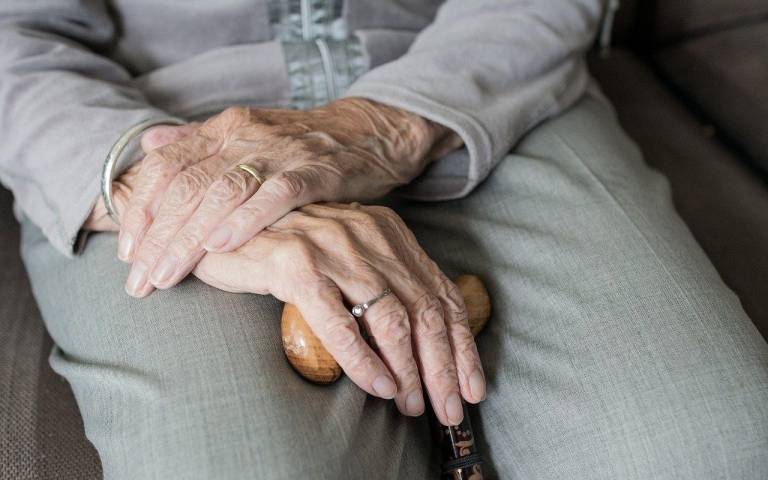Lockdown ease could lead to tens of thousands of excess deaths unless vulnerable are protected
13 May 2020
The risk of death among people with health conditions, such as heart disease or diabetes, is five times higher than in people without underlying conditions and easing the lockdown must take into account this clinical vulnerability, according to new ṗû¶ġÓḞÔẃ-led research.

The study, published today in The Lancet, analysed 3.8 million health records and found that between 37,000 and 73,000 excess deaths could occur from direct and indirect effects of the COVID-19 pandemic within one year depending on how the lockdown is eased.
The team of researchers from ṗû¶ġÓḞÔẃ, ṗû¶ġÓḞÔẃH, University of Cambridge and Health Data Research UK (HDR UK) based their estimates of excess deaths on the population in England having a 10% infection rate and 20% having at least one of the high-risk underlying conditions as listed by Public Health England.
Lead author, Dr Amitava Banerjee (ṗû¶ġÓḞÔẃ Institute of Health Informatics) said: âOlder people, those with one or more underlying conditions and their carers are asking what easing the lockdown might mean for their health. Using data modelling on a number of different scenarios, our findings show the mortality risk for these vulnerable groups increases significantly, and could lead to thousands of avoidable deaths.â
As part of this study, the authors Ìýdeveloped a publicly accessible online ârisk calculatorâ*, showing how age, sex and underlying health conditions (including chronic obstructive pulmonary disease, heart disease, kidney disease, diabetes, and severe obesity) can affect mortality rates in different scenarios of the COVID-19 emergency.
Pre-COVID-19 the one year mortality risk in adults with no underlying health conditions was 0.6%, compared to 3.5% in those with one underlying condition (fivefold increase) and 7.5% in those with two underlying conditions. The researchers modelled the additional effect of the pandemic on top of these background risks, which allows the calculatorâs user to explore changes in the infection rate in the population and the relative impact of the COVID-19 emergency. The relative risk captures both the direct effects of viral infection (e.g. how deadly it is) as well as indirect effects (e.g. health system strain).
Dr Banerjee explained, âOur calculator provides one year mortality risks for common conditions by age and sex. Before the pandemic neither doctors, nor patients have been used to seeing such information, but in the current emergency there is an urgent need to develop better understanding of who is at risk based on reliable health data. What we offer is a prototype, a beta version that we and others can develop further.
âFor example, we show how a 66-year-old man with chronic obstructive pulmonary diseaseÌý(COPD) has a 6% risk of dying over the next year and there are 25 000 âpatients like meâ (i.e. men of the same age with the same condition) in England. The calculator estimates 164 excess COVID-related deaths on top of the expected 1639 deaths over a year in patients in a similar situation.â
Senior author, Professor Harry Hemingway, (ṗû¶ġÓḞÔẃ Institute of Health Informatics and Research Director of Health Data Research UK), said: âThis research isrelevant for the NHS policy on âvulnerableâ patients based on their underlying conditions.
âOur findings emphasise the importance of delivering consistent preventive interventions to people with a wide range of diseases, who are cared for by a wide range of clinical specialties. This policy is only possible because we have an NHS able to use system-wide data for patient benefitâ
Early work from the ṗû¶ġÓḞÔẃ research group in March** highlighted the potential for excess deaths in those who are not infected with coronavirus. This has subsequently been confirmed with weekly reports on death registrations from the Office of National Statistics.
Health Data Research UK (HRR UK) Chief Executive Officer, Caroline Cake, said: âThe Health Data Research Hubs focusing on cardiovascular disease, respiratory disease, cancer, acute medicine and real world evidence are analysing data at scale across the UK to understand and mitigate the direct and indirect causes of excess mortality in the current emergency.â
Professor Hemingway (ṗû¶ġÓḞÔẃ Institute of Health Informatics) concluded: âVaccines and drugs will take time to develop and evaluate.
âWhat works right now is two things. Firstly keeping the population infection rate as low as possible, and avoiding infection in the people at highest risk (direct effects of infection). Secondly we need to continue to deliver high quality medical care to vulnerable people to prevent excess deaths in those who are not infected with corona virus (indirect effects of the emergency).âÌý
Funding for the study was provided from Health Data Research UK (HDRUK), and the National Institute of Health Research (NIHR) ṗû¶ġÓḞÔẃ Hospitals Biomedical Research Centre.ÌýThis work uses data provided by patients and collected by the NHS as part of their care and support.
Links
- Professor Harry Hemingway's academic profile
- ṗû¶ġÓḞÔẃ Institute of Health Informatics
- ṗû¶ġÓḞÔẃ Population Health Sciences
Image
Credit: Hand by SabinevanerpÌý Source: via (CC by 2.0)
Media Contact
Rowan Walker
Tel:Ìý+44 (0)20 3108 8515
Email: rowan.walker [at] ucl.ac.uk
Ìý
 Close
Close

